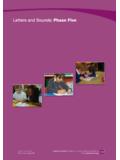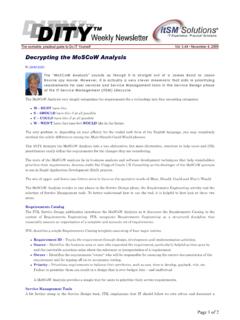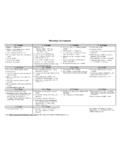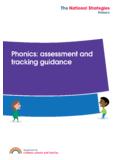Transcription of child with Letters and Sounds
1 How to help your child with .. Letters and Sounds Stanford in the Vale Primary School R Cook, 2011 R Cook, 2011 IntroductionIntroductionIntroductionIntr oduction Children learn a great deal from other people. As parents and carers you are your child s first teachers. You have a powerful influence on your child s early learning. From a very early age your child will need to experience a wide range of activities and experiences with you, for example, sing-ing and saying rhymes, making and listening to music, listening to them and joining in conversations, painting and pretend play, to develop their early reading and writing skills.
2 These activities will help your child take the first important steps towards read-ing and writing. R Cook, 2011 At Stanford in the Vale Primary School children take part in a high-quality communication, language and literacy development programme designed to promote every child s learning. A phonics teaching programme called Letters and Sounds is used to support the teaching of reading and writing. It builds on the activities the children have already experienced at home and in their pre school setting. The children learn through lots of play and activities and are encouraged to use their increasing phonics knowledge in freely chosen activities and their independent work.
3 If you can be involved in helping your child we know it can make a big difference to your child s learning. This booklet will give further information about the Letters and Sounds programme and the best ways to support your child s learning at home. What is Letters and Sounds ?What is Letters and Sounds ?What is Letters and Sounds ?What is Letters and Sounds ? Letters and Sounds is a structured approach to the teaching of phonics, reading and writing, which is used by teachers across England. The content is organised into 6 phases. Children will be ready to progress to each stage at different ages and teaching is or-ganised to best meet individual children s needs.
4 R Cook, 2011 Learning to read and write in the Foundation Learning to read and write in the Foundation Learning to read and write in the Foundation Learning to read and write in the Foundation StageStageStageStage Children s spoken language supports reading and Children s spoken language supports reading and Children s spoken language supports reading and Children s spoken language supports reading and writingwritingwritingwriting From a very early stage, children develop an awareness of the different Sounds in our spoken language. They learn to use their voices to make contact with you and to let people know what they need and how they are feeling.
5 As parents and car-ers, you best understand your baby or young child s communica-tions; you are key people in helping them develop their speaking and listening skills. Children need lots of opportunities to talk with others as they develop and practise their speaking and listening skills. This helps to build their confidence and improves their ability to communicate with other people. This is a really important as-pect of learning to socialise and will help your child feel confi-dent when the time comes to make friends. In order to make a good start in reading and writing, children need an adult to talk to and listen to them.
6 Everyday activities such as preparing meals, tidying up, putting shopping away and getting ready to go out, offer you chances to talk to your child , explaining what you are doing. They hear the way language is put together into sentences for a purpose. R Books are a rich source of new words for your child words you would not use in everyday conversations appear in books. Children need to have a wide stock of words (vocabulary) to understand the meaning of books, so read aloud and share books as often as you can. They will enjoy it and it will be use-ful to them when they come across these words in their own reading later on.
7 Ways you can support your children at home: talking and listeningWays you can support your children at home: talking and listeningWays you can support your children at home: talking and listeningWays you can support your children at home: talking and listening Make time to listen to your child talkingMake time to listen to your child talkingMake time to listen to your child talkingMake time to listen to your child talking as you meet them from school, as you walk, or travel home by car, in the supermar-ket as you shop, at meal times, bath times, bedtimes any time! Switch off the TV, radio and mobile phonesSwitch off the TV, radio and mobile phonesSwitch off the TV, radio and mobile phonesSwitch off the TV, radio and mobile phones and really listen!
8 Show that you are interested in what they are talking aboutShow that you are interested in what they are talking aboutShow that you are interested in what they are talking aboutShow that you are interested in what they are talking about look at your child , smile, nod your head, ask a question or make a response to show that you really have been listening. Make a collection of different toy creaturesMake a collection of different toy creaturesMake a collection of different toy creaturesMake a collection of different toy creatures for example, a duck, a snake, an alien, say the sound it might make as you play together, for example,, quack-quack , ssssssss , yuk-yuk , and encourage your child to copy you.
9 Listen at homeListen at homeListen at homeListen at home switch off the TV and listen to the Sounds both inside and outside the home. Can your child tell you what Sounds they heard, in the order in which they heard them? PlayPlayPlayPlay----aaaa----tunetunetune tune and follow me! Make or buy some simple shakers, drums and beaters, then play a simple tune and ask your child to copy. Have fun! Use puppets Use puppets Use puppets Use puppets and toys to make up stories or retell known ones. Record your child telling the story and play it back to them. R Cook, 2011 The importance of speech soundsThe importance of speech soundsThe importance of speech soundsThe importance of speech Sounds As children grow older they begin to understand more about the Sounds of our language and they are able to join in with rhymes, songs and stories by clapping, stamping and skipping.
10 This is an important stage as the children s ears are learning to tune into all the different Sounds around them. Playing with Sounds and tuning your child s ears into Sounds will develop phonological awareness that is the ability to discriminate different Sounds . Over time, this will help your child de-velop an understanding that words are made up of different Sounds (phonemes) and they will be able to hear the different Sounds in a word. Gradually they will learn to match Sounds to Letters (graphemes). This is phonic knowledge. They use this knowledge when they are read-ing and writing.









